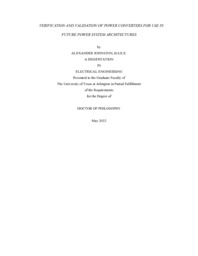
ATTENTION: The works hosted here are being migrated to a new repository that will consolidate resources, improve discoverability, and better show UTA's research impact on the global community. We will update authors as the migration progresses. Please see MavMatrix for more information.
Show simple item record
| dc.contributor.advisor | Wetz, David | |
| dc.creator | Johnston, Alexander | |
| dc.date.accessioned | 2023-06-28T15:36:49Z | |
| dc.date.available | 2023-06-28T15:36:49Z | |
| dc.date.created | 2022-05 | |
| dc.date.issued | 2022-05-23 | |
| dc.date.submitted | May 2022 | |
| dc.identifier.uri | http://hdl.handle.net/10106/31390 | |
| dc.description.abstract | Electronics are more widely penetrating almost every area of society and as they
do, the demand to supply them with regulated power increases considerably. The scale of
the electronic power distribution systems needed ranges from those in very small handheld
consumer electronic devices all the way up to those needed in large buildings, ships, and
cities. The energy supplied within these power distribution systems can come from many
different generation sources that operate either individually or simultaneously. When
power electronics are controlled properly, simultaneous generation sources can be
employed in a way that optimizes them according to the user’s desired parameters. Energy
storage, especially lithium-ion batteries, has emerged as a viable candidate for backing up
and buffering traditional generation sources. It is difficult, from both a cost and feasibility
perspective, to setup and experimentally study large power systems employing distributed
generation sources. Computer aided models can be employed reliability to study the many
different configuration and control strategies. Before they can be properly employed,
accurate device models must be available of all the different distributed sources, power
vi
electronic converters, and loads, respectively. Most of these devices are commercially
procured and the vendors are rarely able and willing to supply all the proprietary circuit
and control technologies needed to develop models of them at the component level. New
strategies are needed to develop these computer aided models and to learn how to put them
through a full verification and validation (V&V) procedure that ensures they meet the
requirements needed to study these systems against all possible use cases. In the work
presented here, a medium voltage (MV) AC/DC testbed has been designed, installed, and
experimentally studied to emulate one zone of a zonal shipboard power system. The testbed
has several different power generation sources, power electronic converters, and loads that
are all being modeled and then put through a V&V procedure. The testbed, computer aided
model development, and V&V process employed on several power electronic converters
will be discussed here. | |
| dc.format.mimetype | application/pdf | |
| dc.language.iso | en_US | |
| dc.subject | Power architecture | |
| dc.subject | Power electronics | |
| dc.subject | Modeling | |
| dc.subject | System identification | |
| dc.subject | Medium voltage | |
| dc.subject | Neural networks | |
| dc.subject | Verification | |
| dc.subject | Validation | |
| dc.title | VERIFICATION AND VALIDATION OF POWER CONVERTERS FOR USE IN FUTURE POWER SYSTEM ARCHITECTURES | |
| dc.type | Thesis | |
| dc.date.updated | 2023-06-28T15:36:49Z | |
| thesis.degree.department | Electrical Engineering | |
| thesis.degree.grantor | The University of Texas at Arlington | |
| thesis.degree.level | Doctoral | |
| thesis.degree.name | Doctor of Philosophy in Electrical Engineering | |
| dc.type.material | text | |
| dc.creator.orcid | 0000-0001-6295-6209 | |
Files in this item
- Name:
- JOHNSTON-DISSERTATION-2022.pdf
- Size:
- 7.260Mb
- Format:
- PDF
This item appears in the following Collection(s)
Show simple item record


